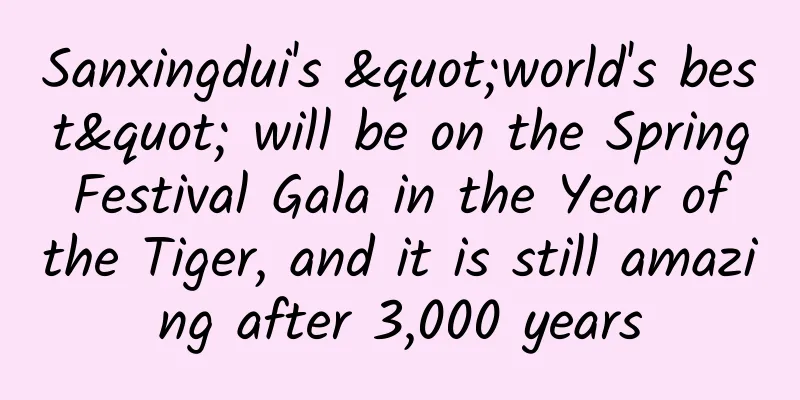Sanxingdui's "world's best" will be on the Spring Festival Gala in the Year of the Tiger, and it is still amazing after 3,000 years

|
On the eve of the Lunar New Year, at the "Sanxingdui Cultural Relics Live Release Ceremony" of the Spring Festival Gala, Ran Honglin, director of the Sanxingdui Archaeological Institute of the Sichuan Provincial Institute of Cultural Relics and Archaeology, released the latest important unearthed cultural relic: the Sanxingdui bronze mask. The large bronze mask unearthed from the Sanxingdui site was shown on the stage of the CCTV Spring Festival Gala This artifact was unearthed from Sanxingdui Pit 3. It is 131cm wide, 71cm high, 66cm deep and weighs 131kg. It is the largest and best-preserved bronze mask unearthed from Sanxingdui Ruins. It has a wide chin and forehead, sharp edges and corners, smooth lines of eyebrows, eyes, lips, etc., all protruding from the face, and thick and long eyebrows are raised. There are square holes on both sides of the mask and in the middle of the forehead, which may be used for fixing. The large bronze mask is a typical artifact of the Sanxingdui culture. It is more than 3,000 years old and reflects the ancient Shu ancestors' understanding and thinking of all things in nature and the world of humans and gods. According to archaeological research, the casting technology and alloy ratio of the large bronze mask belong to the same system as the Anyang Yin Ruins, reflecting the profound influence of Central Plains culture on Sanxingdui culture and confirming the diversity, unity and profoundness of Chinese civilization. Archaeologists peel away layer after layer of earth, opening up an ancient time, scanning history, and searching for the ancient codes left by the ancient Shu civilization. This is a sentiment that we cannot let go of. The world's largest bronze mask The Sanxingdui Ruins are located in Guanghan City, Sichuan Province, about 40 kilometers south of Chengdu city. It is one of the most important ancient sites in the pre-Qin period in the southwest region. On the afternoon of June 23, 2021, with the amazement and cheers of all the Sanxingdui archaeological team members, this large bronze mask broke out of the ground and came to the world! It is more than 3,000 years old and is the largest and most complete bronze mask known to date. According to Ran Honglin, when the mask was unearthed, its face was facing downwards, the tip of its nose was buried deep in the loess, and nearly ten ivory tusks were stacked on top of it. After more than three months of meticulous cleaning, the large bronze mask was fully exposed. On June 23, 2021, archaeological and cultural heritage experts extracted the mask from the pit according to a carefully planned plan. More than 3,000 years ago, the ancient Shu people used it to communicate with gods This bronze mask is very well preserved, with only the left ear falling off and the back of the left cheek and the corner of the mouth slightly damaged. Cultural relics protection personnel have analyzed and studied the casting process of the large bronze mask. The production is first cast separately, and the face, back of the cheek, eyes, ears and other parts are cast separately, and then welded together. This is not only a perfect combination of bronze technology and art, but also a unique expression of the spiritual world of the ancient Shu people. In addition, silk residues were found at the right eye of the mask. The combination of silk and mask, which was believed to have the function of "connecting to heaven and gods" in the ancient Shu civilization, highlights the connotation of sacred sacrifice and has become an important material evidence for the study of Sanxingdui silk. Silk residue was found on the right eye of the mask Image source: Sichuan News As a major project of "Archaeology China", the excavation of Sanxingdui ruins is also a typical representative of China's century-long archaeological achievements. Since its discovery in 1929, generations of archaeologists have continued to struggle for a century and explore the roots of civilization. As of the end of 2021, Sanxingdui has only discovered six new sacrificial pits, with a total of more than 10,000 numbered cultural relics unearthed, including golden masks, top-shaped human figures, round and square vases, large masks, altar models, kneeling bronze figures, more than 500 ivory tusks and many other exquisite cultural relics, some of which can be viewed up close in the Sanxingdui Open Cultural Relics Restoration Museum. Many cultural relics such as bronze vases, bronze huts, jade scepters, jade congs, etc. show the close connection between Shu and the cultures of the Central Plains and the middle and lower reaches of the Yangtze River, and verify the historical development process of the pluralistic and unified Chinese civilization. Since the Sanxingdui site was discovered in 1986, eight "pits" have been discovered, and a large number of exquisite bronze, jade, gold, ivory and other cultural relics have been unearthed. These pits are generally called "sacrificial pits" in the academic community. The cultural relics unearthed here are not burial objects at all. The academic community has found that whether it is the bronze standing man, the bronze sacred tree, the bronze mask, or the national treasure bronze top statue and bronze altar discovered last year, they all clearly point to Sanxingdui as an ancient theocracy. These artifacts were the medium used to communicate between heaven, earth, people and gods at that time and were used for sacrifices. The jade halberd for mountain sacrifice unearthed in Sanxingdui clearly engraved the sacrificial scene at that time. From this perspective, the cultural relics unearthed in Sanxingdui have more auspicious meanings than the burial objects. At present, there is a view in the academic community that among the eight "sacrificial pits" in Sanxingdui, the other six pits except Pits 5 and 6 may be the burial places of sacrificial objects due to some external factors, and Pits 5 and 6, where the gold mask and mysterious wooden box were unearthed, may be the place for sacrifice. In general, the areas where the eight pits are located are all sacrificial areas of the ancient Shu Kingdom. "Blind Box" New Year of the Tiger: Bronze Dragon and Tiger "Mythical Beasts" are about to appear Before that, with the arrival of the Lunar New Year of the Tiger, Sanxingdui "blind box" was launched again, and a bronze dragon and tiger "mythical beast" with a tiger head and a tiger body was found in the No. 8 "sacrificial pit". The newly discovered bronze statue with a tiger head and a dragon body in the No. 8 "Sacrificial Pit" of Sanxingdui. Image source: Xinhuanet Photo by Zhao Hao It has two horns on its head, a body with tiger stripes on a gold background, and is half dragon and half tiger, in a strange shape... Zhao Hao, an associate professor at the School of Archaeology and Museology of Peking University, who is in charge of the excavation of the No. 8 "Sacrificial Pit", introduced that this is another unprecedented bronze ware and temporarily named it the bronze statue with a tiger head and a dragon body. Head of a bronze statue with a tiger head and a dragon body. Image source: Xinhuanet Photo by Zhao Hao "When we lifted the last layer of ivory on top of the artifact, we were all very excited, because the excavation staff on site were convinced that they would see an artifact that had never been seen before." This is how Zhao Hao described his feelings when he saw this cultural relic for the first time. The "tiger stripes" on the body of the bronze statue with a tiger head and a dragon body. Image source: Xinhuanet Photo by Zhao Hao Zhao Hao said that the front limbs of this bronze statue with a tiger head and a dragon body stand on a triangular copper bracket, the back body is tilted up, the hind limbs are welded to another piece, and there is a blade in its mouth. There is also a bird standing in the front section, and the negative lines on the surface of the bird's body are filled with cinnabar. The most interesting thing is that a very round eyeball is dotted in the middle of the eyes of the bronze statue with a tiger head and a dragon body with black paint (the material has not been tested yet), which can be called the finishing touch. The base of the cultural relic currently seen is 55 cm wide and 85 cm high, and part of it is still in the soil. The overall appearance is very worth looking forward to. "Dragon shapes have appeared in Sanxingdui before, but this is the first time that they have appeared in this size and in the form of a round sculpture. There is still a lot of soil on the surface of the cultural relics that has not been cleaned up. I believe it will be very gorgeous after it is cleaned up." Zhao Hao said. How much do you know about Sanxingdui? Comprehensive sources: Xinhuanet, CCTV News Client, Sichuan News, etc. |
<<: The first day of the Chinese New Year is here! Have you forgotten these things? Check them out
>>: Pray to gods for peace and prosperity, but do you know who these "gods" are?
Recommend
Australia bans artificial stone, causing incurable diseases for 600 people
Recently, Australia announced at a conference tha...
From IOUs to smart logistics, why is JD.com's big data more promising than AlphaGo?
A round of Go competition between man and machine...
3 store owners share their own experiences to reveal how tricky the Double Eleven shopping spree is.
What can you think of on 11.11? Is it Singles'...
How to acquire customers at low cost through Zhihu promotion?
Before doing promotion, I think you should at lea...
How to give a mini program a “good name”?
Q: How to give a mini program a “good name”? A: N...
"I am your wall breaker!" Air & Water: ...
Did you know that there is a "wall" bet...
How to use channels to achieve user growth?
There are many entrepreneurs around me. Most of t...
How much does it cost to customize a small program in Guangzhou?
In fact, there are ways to develop WeChat applets...
There are obviously not many cars and no accidents, so why is there a traffic jam?
Audit expert: Zhu Guangsi Member of Beijing Scien...
Do you know where the osmanthus tree on the moon came from?
I remember when I was a child, on the night of th...
Apple has really changed. The Apple retail store that Steve Jobs often visited during his lifetime has now switched to selling shoes.
As an important means for Apple to maintain and d...
25 types of popular article title routines on Toutiao, you have to admire them!
Compared with the headline party in Toutiao The p...
At the end of September, the number of 5G mobile phone terminal connections in China reached 445 million
This year, China has accelerated the construction...
A brief analysis of the 7 types of super traffic content
What kind of content can attract users' atten...









